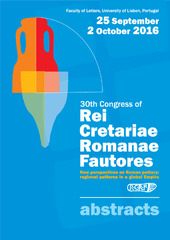Приказ основних података о документу
Viminacium workshop relief pottery – new motifs and dating
| dc.creator | Raičković Savić, Angelina | |
| dc.creator | Bogdanović, Ana | |
| dc.creator | Nikolić, Snežana | |
| dc.date.accessioned | 2023-10-05T07:03:56Z | |
| dc.date.available | 2023-10-05T07:03:56Z | |
| dc.date.issued | 2016 | |
| dc.identifier.uri | http://rai.ai.ac.rs/handle/123456789/636 | |
| dc.description.abstract | As the capital of Moesia Superior, Viminacium represented the largest workshop centre in this Roman province. Within various craft activities, the production of pottery objects was highly developed. Bricks, lamps, terracotta figurines and many other objects were produced within the Viminacium pottery workshops, while the production of ceramic vessels certainly was one of the most important ones. Apart from pottery used in everyday life, luxury rendered vessels were also made, but in a much smaller number. Among luxury ceramics, specimens that are created according to the model of imported vessels made of terra sigillata, are distinguished in number, and their surfaces were usually decorated with relief ornament. The production of these vessels was confirmed with numerous findings a long time ago, both the pottery and moulds in which they were made. From recent excavations of Viminacium, which are continuously carried out nearly two decades, numerous specimens of relief decorated vessels are of local craftsmanship, and most of them were found in the area of the amphitheatre. These new findings confirmed previously acquired knowledge about this ceramic group. The form of these vessels, manner and quality of their production, as well as motifs used for decoration, do not differ significantly from the specimens discovered earlier. The significance of these new findings largely refers to the fact that owing to the context of some finding, more precise production dating and usage of these vessels are now possible. With these new findings the variety of forms and motifs in their decoration are enriched, especially in the case of glazed ceramics. The location of Viminacium workshop for the production of luxury ceramics remains in the domain of the logical assumption, for now, and it can be suggested that it was located on the periphery of the settlement, near the Mlava river, where the greatest number of moulds was found. | sr |
| dc.language.iso | en | sr |
| dc.publisher | Lisboa : UNIARQ - Centro de Arqueologia da Universidade de Lisboa. Faculdade de Letras. Universidade de Lisboa | sr |
| dc.rights | openAccess | sr |
| dc.source | New Perspectives on Roman Pottery: Regional Patterns in a Global Empire : 30th Congress of the Rei Cretatiae Romanae Fautores : abstracts | sr |
| dc.subject | Viminacium | sr |
| dc.subject | workshop relief pottery | sr |
| dc.subject | new motifs and dating | sr |
| dc.subject | Roman Pottery | sr |
| dc.title | Viminacium workshop relief pottery – new motifs and dating | sr |
| dc.type | conferenceObject | sr |
| dc.rights.license | ARR | sr |
| dc.citation.epage | 28 | |
| dc.citation.spage | 28 | |
| dc.identifier.fulltext | http://rai.ai.ac.rs/bitstream/id/1971/bitstream_1971.pdf | |
| dc.identifier.rcub | https://hdl.handle.net/21.15107/rcub_rai_636 | |
| dc.type.version | publishedVersion | sr |


